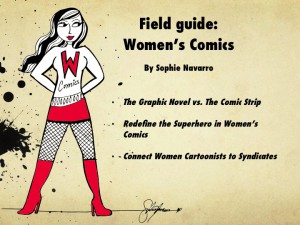
Field Guide Women’s Comics
Field Guide: Art In Society Comics
Historical content – Women cartoonists in the U.S.
When I think of comics, cartoons and graphic novels, I think of images connected with words (Text). The stories are often told in series or miniseries. Some are turned into graphic novels. Comics done by women started as early as 1897 and is categorized by different ages: Platinum Age, Golden Age/Silver Age, Bronze Age and Modern Age, American Manga, Alternative comics and American comic strips.
The difference between a comic and a graphic novel is that a comic is a magazine with volume and issue numbers. A graphic novel is a single issue (publication).
http://en.wikipedia.org/wiki/List_of_female_comics_creators

Jackie Ormes NY Times
Jackie Ormes http://www.nytimes.com/2008/03/30/books/review/Wolk2-t.html?_r=0

Celebrates 20 Years!
Cartoonist
Cissie Peltz celebrates 20th Anniversary
http://www.jsonline.com/blogs/entertainment/51414437.html
Section 2. Setting = a description of the participants, community, and/or context for the subject introduced in Section I.
I am interested in the art world of comics and cartooning. I find the world important due to the nature of how challenging it is to write and illustrate a comic strip. I want to explore the dynamic between the cartoonist and the syndicate. What is the relationship between them? How does a cartoonist publish their work and sustain their work.
I am choosing several artists in the pacific northwest as well as looking at other women cartoonists in American history. I am finding that many of them are connected and help one another as mentors. I met with Jan Eliot on November 1st and what I learned after meeting with her that in order to work in the field, one must understand how the work is drawn on paper and then printed in a newspaper. You must draw with specific pens and draw bigger than you might think. Jan suggested “Take one of my comics from the Sunday paper and blow it up on a printer and you will be surprised by seeing how large you must be drawing in order for the strip to be readable. The work must be legible in order to be printed well.” She offered realistic advice regarding my own work and it was very helpful to me. She also suggested several resources to check out like Go Comics. It is a great collection of comics by a variety of cartoonists. She recommended that I talk with Dana Simpson who writes “Heavenly Nostrils” which is about a little girl and her unicorn. She says she is based in Seattle and she is on Go Comics and she also published a book. Her book is in the young adult section. It’s about Phoebe and her Unicorn. She suggested that writing what I know about is also really helpful. I suggested that I write about divorce and parenting. We laughed about how that would be a great topic. I know I have so much material regarding what you go through and it gives me a place to release all the stress that can come with post-divorce. My goal is to write and illustrate a comic book called “The Guide to a smooth divorce and a handy tool kit to navigate the journey. I learned a great deal with Jan. Comics are an art form that one cannot rush. You must prep up your writing first and create many test runs to try out your gag lines. Character development takes time and style comes with practice.
Section 3. Transmediations = a narrated tour through a minimum of 7 transmedia resources that you used to map your subject.
- Lily Renée Wilheim Peters Phillips, (born Lily Renée Wilheim, c. 1925, Vienna, Austria), often credited as L. Renée, Lily Renée, or Reney, is an Austrian-American artist, writer, and playwright. She escaped from Nazi-occupied Vienna to England and later New York, whereupon she found work as a penciller at Fiction House on such titles as The Werewolf Hunter, Jane Martin and Senorita Rio.
This gallery contains 1 photo.




